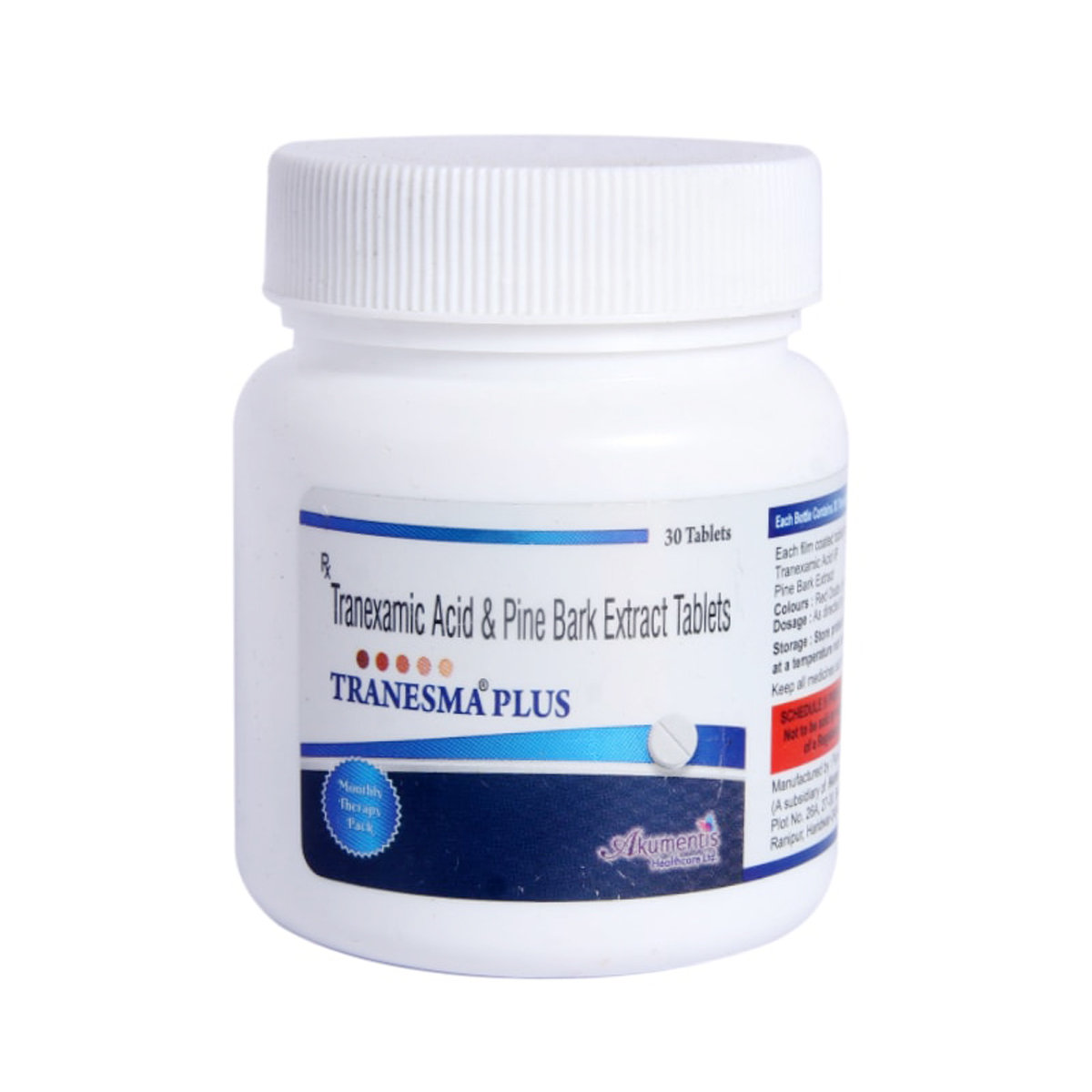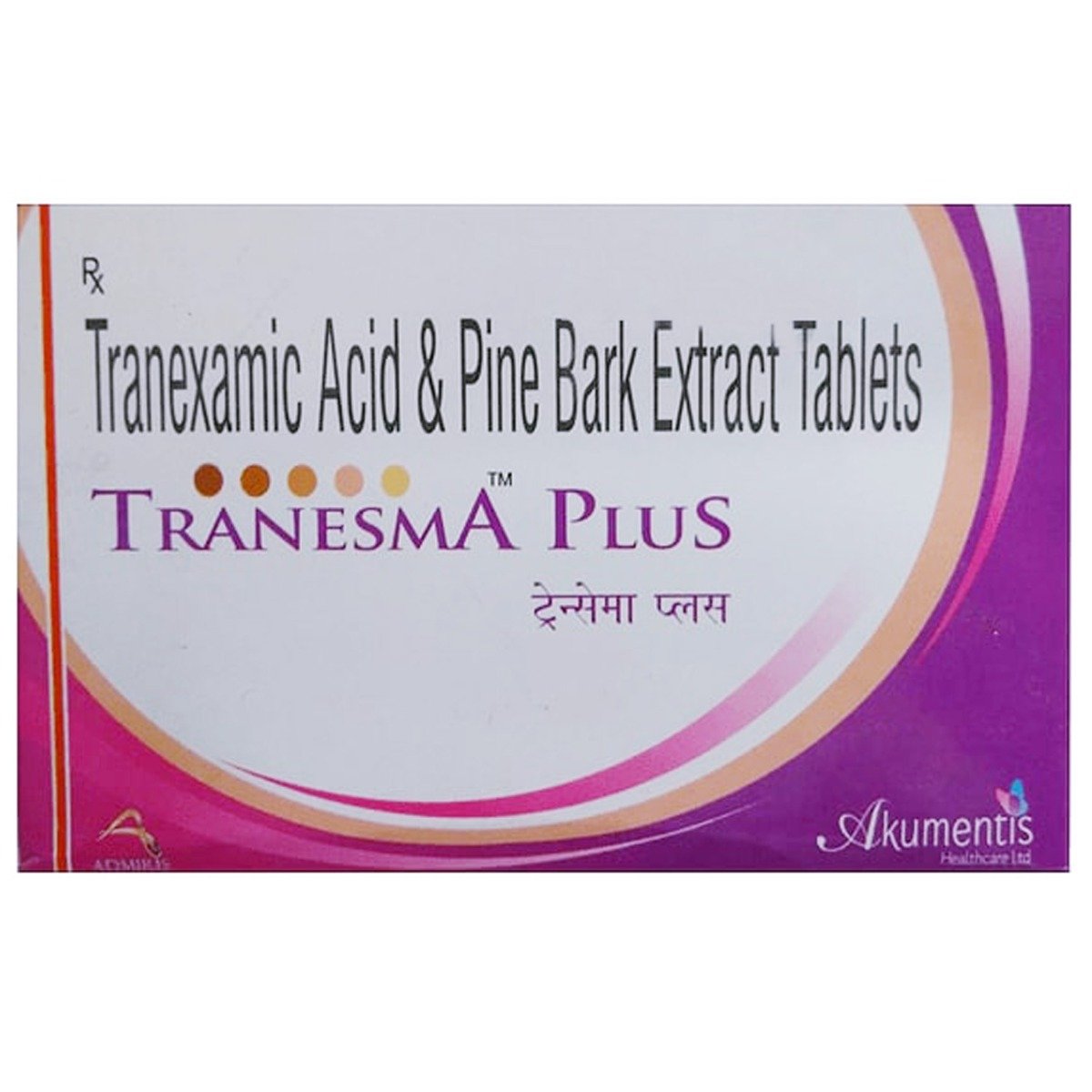Depishine-TX Tablet 10's


MRP ₹178
(Inclusive of all Taxes)
₹26.7 Cashback (15%)
Provide Delivery Location
Online payment accepted
 Prescription drug
Prescription drugWhats That
Composition :
Manufacturer/Marketer :
Consume Type :
Expires on or after :
Return Policy :
About Depishine-TX Tablet
Depishine-TX Tablet belongs to the class of medications called ‘Anti-hemorrhagic agents’ used to control bleeding, especially for menorrhagia and nose bleeds. Menorrhagia is a medical condition where menstrual bleeding lasts longer than seven days. It could be intense bleeding. The loss of blood that occurs from the tissue that lines the inside of your nose is known as a nosebleed.
Depishine-TX Tablet is a combination of two medicines: tranexamic acid and pine bark extract. Tranexamic acid is an anti-fibrinolytic medication. It aids in the prevention of fibrinolysis by preventing the breakdown of fibrin. Pine bark extract has essential anti-inflammatory and anti-thrombotic properties that may benefit patients with hemorrhoids, both acute and chronic treatment. Thereby Depishine-TX Tablet treats heavy bleeding.
You should use this medicine as prescribed by your doctor. Most people do not have any side effects while taking Depishine-TX Tablet . However, in few cases, it may cause side effects such as nausea (feeling sick), diarrhoea, and itchy red skin. The majority of these side effects do not necessitate medical treatment and will subside gradually over time. However, if you regularly have these adverse effects, you should seek medical attention.
Depishine-TX Tablet is not suitable for some people. To ensure that Depishine-TX Tablet is safe for you, tell your doctor if you have ever had an allergic reaction to tranexamic acid, pine bark extract, or any other medicine, if you have a history of kidney problems, DVT (deep vein thrombosis) or pulmonary embolism (blocked blood vessel in your lungs), coagulopathy (a rare condition where lots of small blood clots form in your blood followed by abnormal bleeding), epilepsy, irregular periods, and visual disturbances. Also, inform your doctor if you are pregnant or breastfeeding.
Uses of Depishine-TX Tablet
Directions for Use
Key Benefits
Depishine-TX Tablet contains tranexamic acid and pine bark extract. Tranexamic acid is an anti-fibrinolytic medication. It aids in the prevention of fibrinolysis by preventing the breakdown of fibrin. Pine bark extract has essential anti-inflammatory and anti-thrombotic properties that may benefit patients with haemorrhoids, both acute and chronic treatment. Thereby Depishine-TX Tablet treats heavy bleeding.
Storage
- Muscle cramps can be treated with regular exercise or yoga, which includes mild stretching, which helps strengthen the lower body.
- Warm baths and gentle massage of the affected parts can help relieve cramps.
- Avoid strenuous activity and take frequent breaks, as rest is critical.
- Intake of nutritious food can help strengthen body and mind. A trained nutritionist can help design a balanced diet for strengthening muscles.
- Speak to your doctor if the pain lasts an extended period. Medical help can be practical in finding a cure for cramps.
- Drink water or other clear fluids.
- To prevent worsening of pain, limit intake of tea, coffee, or alcohol.
- Include bland foods like rice, toast, crackers, and rice in your diet.
- Avoid lying down immediately after eating as it may cause indigestion or heartburn.
- Avoid acidic and spicy food as it may cause indigestion.
Drug Warnings
Depishine-TX Tablet is not suitable for some people. To ensure that Depishine-TX Tablet is safe for you, tell your doctor if you have ever had an allergic reaction to tranexamic acid, pine bark extract, or any other medicine, if you have a history of kidney problems, DVT (deep vein thrombosis) or pulmonary embolism (blocked blood vessel in your lungs), coagulopathy (a rare condition where lots of small blood clots form in your blood followed by abnormal bleeding), epilepsy, irregular periods, and visual disturbances. And also, inform your doctor if you are pregnant or breastfeeding.
Drug-Drug Interactions
Drug-Drug Interactions
Login/Sign Up
Taking drospirenone with Depishine-TX Tablet may increase the risk of blood clot formation.
How to manage the interaction:
Taking Depishine-TX Tablet with Drospirenone is not recommended, as it can lead to an interaction but can be taken if prescribed by the doctor. However, If you suffer from chest discomfort, shortness of breath, blood in the urine, blood in the cough, sudden loss of vision, and pain, redness, or swelling in your arm or leg, consult your doctor immediately.
Taking Levonorgestrel with Depishine-TX Tablet may increase the risk of blood clot formation which can lead to serious conditions such as heart problems and kidney failure.
How to manage the interaction:
Taking Depishine-TX Tablet with Levonorgestrel may leads to an interaction but can be taken if prescribed by the doctor. However, if you experience chest pain; shortness of breath; coughing up blood; blood in the urine; sudden loss of vision; and pain, redness, or swelling in your arm or leg, consult the doctor immediately. Do not stop using any medications without talking to a doctor.
Taking Ethinylestradiol with Depishine-TX Tablet may increase the risk of blood clot formation.
How to manage the interaction:
Taking Ethinylestradiol with Depishine-TX Tablet is not recommended, as it can lead to an interaction, but can be taken if a doctor has prescribed it. However, if you suffer from chest discomfort, shortness of breath, blood in the urine, blood in the cough, sudden loss of vision, and pain, redness, or swelling in your arm or leg, consult doctor immediately. Do not stop using any medications without talking to a doctor.
Taking Medroxyprogesterone acetate with Depishine-TX Tablet may increase the risk of blood clots.
How to manage the interaction:
Taking Medroxyprogesterone with Depishine-TX Tablet is not recommended but can be taken if prescribed by a doctor. Consult your doctor immediately if you experience symptoms such as chest pain, shortness of breath, coughing up blood, blood in the urine, sudden loss of vision, and pain, redness, or swelling in your arm or leg. Do not stop using any medications without talking to your doctor.
Co-administration of Depishine-TX Tablet may cause blood clotting when taken with Etonogestrel.
How to manage the interaction:
Taking Depishine-TX Tablet with Etonogestrel is not recommended, as it can lead to an interaction but can be taken if prescribed by the doctor. However, If you suffer from chest discomfort, shortness of breath, blood in the urine, blood in the cough, sudden loss of vision, and pain, redness, or swelling in your arm or leg, consult your doctor immediately.
Using Depishine-TX Tablet together with norethindrone may increase the risk of blood clots.
How to manage the interaction:
Taking norethisterone with Depishine-TX Tablet can lead to an interaction, however, it can be taken only if a doctor has advised it. If you experience symptoms such as chest pain, shortness of breath, coughing up blood, blood in the urine, sudden loss of vision, and pain, redness, or swelling in your arm or leg, contact a doctor immediately .Do not discontinue any medications without consulting a doctor.
Co-administration of Carfilzomib with Depishine-TX Tablet can increase the risk of blood clots.
How to manage the interaction:
Taking carfilzomib with Depishine-TX Tablet is not recommended due to its increased effects, however, it can be taken only if a doctor has advised it. If you experience symptoms such as chest pain, shortness of breath, difficulty breathing, coughing up blood, sudden loss of vision, pain, and numbness or weakness on one side of the body contact a doctor immediately. Do not discontinue any medications without consulting a doctor.
Co-administration of Estramustine with Depishine-TX Tablet can increase the risk of blood clots.
How to manage the interaction:
Taking Estramustine with Depishine-TX Tablet possibly lead to an interaction, however, it can be taken only if a doctor has advised it. If you experience symptoms such as chest pain, shortness of breath, difficulty breathing, coughing up blood, sudden loss of vision, pain, and numbness or weakness on one side of the body contact a doctor immediately. Do not discontinue any medications without consulting a doctor.
Co-administration of tamoxifen with Depishine-TX Tablet can increase the risk of blood clots.
How to manage the interaction:
Although taking tamoxifen and Depishine-TX Tablet together can possibly result in an interaction, it can be taken if your doctor has prescribed it. However, consult the doctor immediately if you experience symptoms such as chest pain, shortness of breath, difficulty breathing, coughing up blood, sudden loss of vision, pain, redness or swelling in an arm or leg, and numbness or weakness on one side of the body. Do not discontinue any medications without consulting a doctor.
Co-administration of tretinoin with Depishine-TX Tablet may increase the risk of blood clots.
How to manage the interaction:
Taking tretinoin with Depishine-TX Tablet is not recommended due to its increased effects, however, it can be taken only if your doctor has advised it. If you experience symptoms such as chest pain, difficulty breathing, coughing up blood, sudden loss of vision, pain, and numbness or weakness on one side of the body contact a doctor immediately. Do not discontinue any medications without consulting a doctor.
Drug-Food Interactions
Drug-Food Interactions
Login/Sign Up
Diet & Lifestyle Advise
- Drink plenty of fluids to stay hydrated. Fluids are necessary to maintain blood flow in your body.
- Include a diet that includes omega–3 fatty acids, Fiber, and Antioxidants such as flaxseeds, fruits, vegetables, nuts, and beans.
- Instead of saturated and trans-fats, choose monounsaturated and polyunsaturated fats (fish, nuts, and vegetable oils).
- Select/prepare foods and beverages with less added sugars/caloric sweeteners.
- Limit or avoid alcohol consumption.
- Avoid physical and psychological stress.
- Replace fatty protein sources with lean alternatives and consume modest quantities of healthy fat sources for improved wellbeing.
Side Effects of Depishine-TX Tablet
- Feeling sick (nausea)
- Diarrhoea
- Itchy red skin
- Stomach upset
- Headaches
Habit Forming
Therapeutic Class
All Substitutes & Brand Comparisons
RX
Cuteglow Plus Tablet 10's
Cute Care Life Sciences Pvt Ltd
₹145
(₹13.05 per unit)
18% CHEAPERRX
Out of StockMlsma TX Tablet
₹187
(₹16.83 per unit)
5% COSTLIERRX
Tranesma Plus Tablet 30's
Akumentis Healthcare Ltd
₹609
(₹18.27 per unit)
14% COSTLIER
Product Substitutes
Author Details
We provide you with authentic, trustworthy and relevant information
Drug-Diseases Interactions
Drug-Diseases Interactions
Login/Sign Up
FAQs
Depishine-TX Tablet contains tranexamic acid and pine bark extract. Tranexamic acid is an anti-fibrinolytic medication. It aids in the prevention of fibrinolysis by preventing the breakdown of fibrin. This aids in the retention of blood clots in areas where they are required. Pine bark extract has essential anti-inflammatory and anti-thrombotic properties that may benefit patients with hemorrhoids, both acute and chronic treatment. Thereby Depishine-TX Tablet treats heavy bleeding.
Caution should be exercised while using Depishine-TX Tablet in patients with pulmonary embolism (blocked blood vessels in your lungs). Let your doctor know about your present health condition before taking Depishine-TX Tablet .
If you get diarrhoea after using the Depishine-TX Tablet , drink plenty of water to avoid dehydration. If it persists, consult your doctor. Without a doctor's prescription, do not attempt to take antidiarrheal medication.
Depishine-TX Tablet is usually used for a short time to treat bleeding. You are recommended to take Depishine-TX Tablet for as long as it is prescribed by a doctor to treat heavy periods. If you notice no improvement, please consult your doctor.
Disease/Condition Glossary
Menorrhagia: It is a medical condition where menstrual bleeding lasts longer than seven days. It could be intense bleeding. This kind of abnormal uterine bleeding is common in women. It can be caused by various disorders, including uterine issues, hormonal imbalances (oestrogen and progesterone, and other hormones), or other factors. Heavy periods may not usually necessitate treatment. However, some treatments can assist if they're interfering with your daily life.
Nose bleed: The loss of blood that occurs from the tissue that lines the inside of your nose is known as a nosebleed. This can be caused due to picking your nose, blowing your nose too hard, and the inside of your nose being too dry (maybe because of a change in air temperature).

Have a query?
Buy best Vascular System products by
Emcure Pharmaceuticals Ltd
Intas Pharmaceuticals Ltd
Lupin Ltd
Ozone Pharmaceuticals Ltd
Sun Pharmaceutical Industries Ltd
Cipla Ltd
Leeford Healthcare Ltd
Mercury Laboratories Ltd
Torrent Pharmaceuticals Ltd
FDC Ltd
Macleods Pharmaceuticals Ltd
Akumentis Healthcare Ltd
Dr Reddy's Laboratories Ltd
Indoco Remedies Ltd
Mankind Pharma Pvt Ltd
Oaknet Healthcare Pvt Ltd
Reliance Formulation Pvt Ltd
Samarth Life Sciences Pvt Ltd
Walter Bushnell
Wanbury Ltd
Abbott India Ltd
Eris Life Sciences Ltd
Galcare Pharmaceuticals Pvt Ltd
Juggat Pharma Ltd
Knoll Pharmaceuticals Ltd
Kontest Pharmaceuticals
Saf Fermion Ltd
Serdia Pharmaceuticals India Pvt Ltd
Systopic Laboratories Pvt Ltd
Themis Chemicals Ltd
Akcent Healthcare India Pvt Ltd
Alembic Pharmaceuticals Ltd
Amelia Healthcare Pvt Ltd
Canixa Life Sciences Pvt Ltd
East West Pharma India Pvt Ltd
German Remedies Ltd
Glenmark Pharmaceuticals Ltd
Ipca Laboratories Ltd
La Pristine Bioceuticals Pvt Ltd
Morepen Laboratories Ltd
Nexgen Rx Life Science Pvt Ltd
Pfizer Ltd
Rapross Pharmaceuticals Pvt Ltd
Sumac Pharma Pvt Ltd
Theia Health Care Pvt Ltd
Themis Medicare Ltd
Themis Pharmaceutical Ltd
4Care Lifesciences Pvt Ltd
Aar Ess Remedies Pvt Ltd
Aarux Pharmaceuticals Pvt Ltd
Alna Biotech Pvt Ltd
Aphia Healthcare
Aristo Pharmaceuticals Pvt Ltd
Baxter India Pvt Ltd
Bennet Pharmaceuticals Ltd
Bharat Serums and Vaccines Ltd
Biosys Pharmaceuticals Ltd
Bros Enterprises Ltd
Celebrity Biopharma Ltd
Chemo Healthcare Pvt Ltd
Cibeles Pharmaceuticals Pvt Ltd
Comed Chemicals Ltd
Conatus Healthcare Pvt Ltd
Cresha Lifesciences
Cute Care Life Sciences Pvt Ltd
Elbrit Life Sciences Pvt Ltd
Euro Biogenics
Icon Life Sciences
J B Chemicals & Pharmaceuticals Ltd
Kee Pharma Ltd
Kemiq Lifesciences Pvt Ltd
Kivi Labs Ltd
Lincoln Pharmaceuticals Ltd
Medchronic Health Care
Medgen Drugs And Laboratories Pvt Ltd
Megma Healthcare Pvt Ltd
Novartis India Ltd
Olcare Laboratories Pvt Ltd
Ornate Labs Pvt Ltd
Q Check Pharmaceuticals
Saan Labs
Stadmed Pvt Ltd
Std Pharmaceuticals Pvt Ltd
Zydus Cadila
3G Life Sciences
Accent Pharmaceuticals & Diagnostics
Adroit Biomed Ltd
Aishwarya Healthcare
Ajanta Pharma Ltd
Akesiss Pharma Pvt Ltd
Albert David Ltd
Algen Healthcare Ltd
Amazone Pharmaceuticals Pvt Ltd
Amstel Pharma Pvt Ltd
Anhox Healthcare Pvt Ltd
Apios Lifesciences Pvt Ltd
Args India Pharma Pvt Ltd
Ark Life Science Pvt Ltd
Arvincare
Aztomax Biotech
Alcohol
Safe if prescribed
No interaction was found. However, it is best to avoid alcohol while taking medication as a precautionary measure.
Pregnancy
Consult your doctor
There are no adequate and well-controlled pregnancy studies. Your doctor will only prescribe if the benefits outweigh the risks.
Breast Feeding
Consult your doctor
Tranexamic acid may be present in trace concentrations in breast milk. However, please consult a doctor if you are a breastfeeding mother.
Driving
Safe if prescribed
Depishine-TX Tablet will not impair your ability to drive or operate machines. However, do not drive if you experience any symptoms that affect your ability to concentrate and react.
Liver
Consult your doctor
Depishine-TX Tablet is probably safe in patients with liver diseases. Consult your doctor for further advice if you have any concerns about this.
Kidney
Consult your doctor
Depishine-TX Tablet to be taken with caution, especially if you have a history of Kidney diseases/conditions. The dose may have to be adjusted by your doctor.
Children
Safe if prescribed
Limited information is available for the use of Depishine-TX Tablet in pediatric patients. Your doctor will prescribe only if the benefits outweigh the risks.







